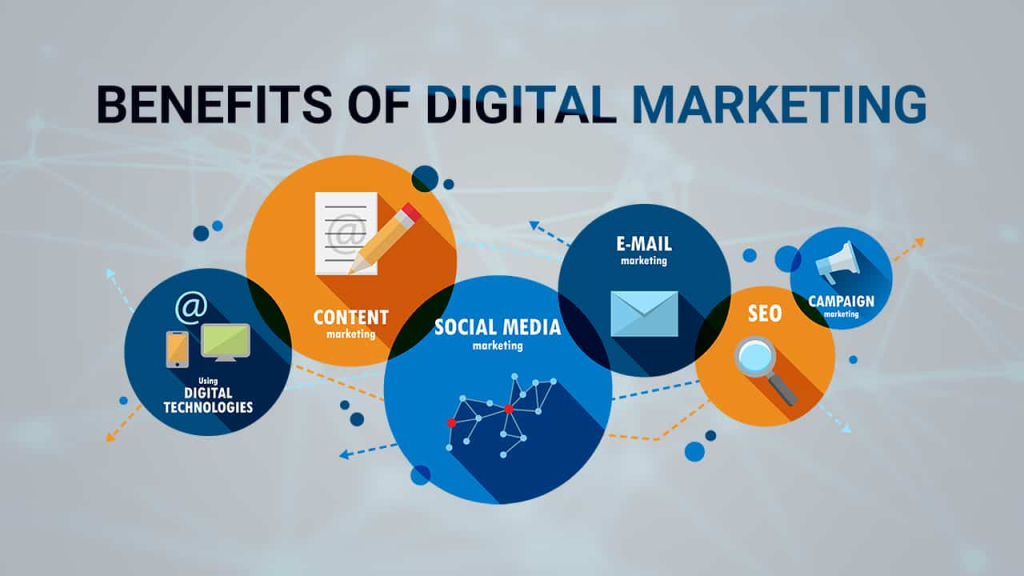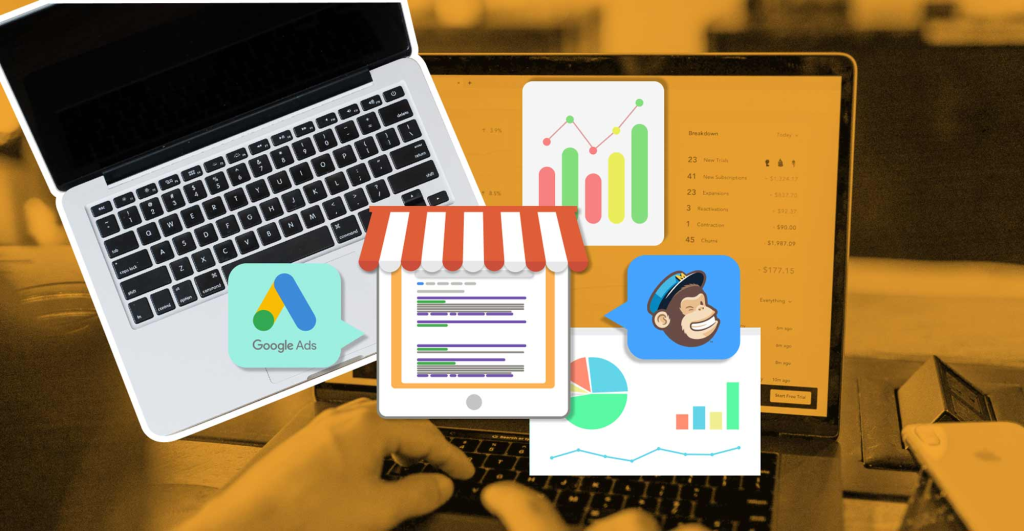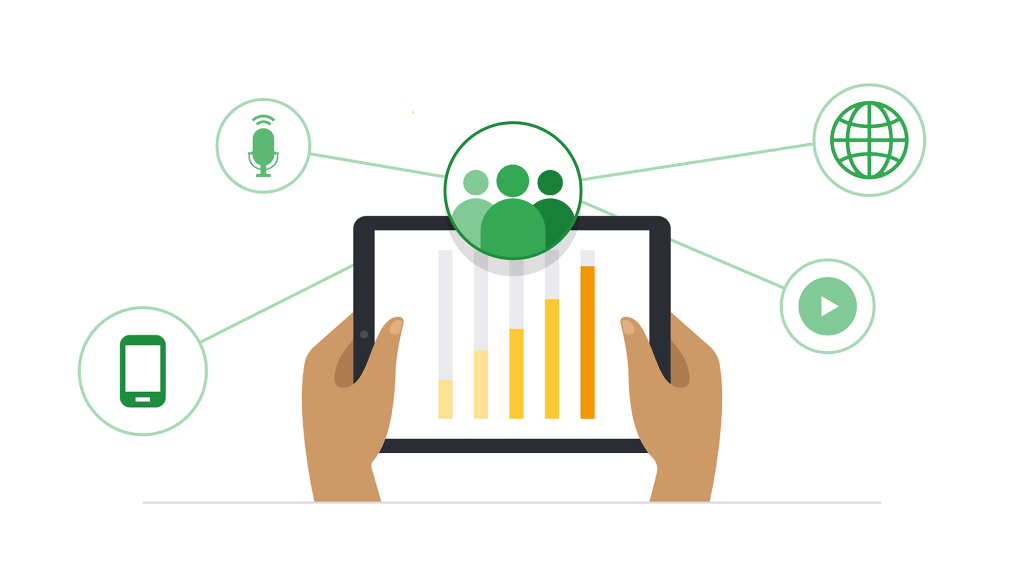
When small businesses embark on their journey, their initial focus often revolves around attracting their first customers. They might rely on conventional advertising methods like print ads, coupon mailers, or even outdoor billboards. They may hold the belief that offering a quality product or service will eventually lead customers to their doorstep.
While this approach may yield some business, there exists a more effective and convenient method. Small businesses should recognize the potential of the vast online marketplace and leverage the fusion of traditional and digital marketing. No matter how new or small the business may be, neglecting digital channels as a means to generate leads and convert interest into customers would be a missed opportunity.
Now, let’s explore the advantages of digital marketing and the various ways online platforms can be utilized to foster the growth of your business.
Benefits of Online Marketing

The online realm presents a vast pool of potential customers that far surpasses the local reach of a business. By utilizing digital marketing techniques, it becomes possible to connect with a global audience in a cost-effective, scalable, and measurable manner.
Digital marketing offers several key advantages, including:
- Enhanced Customer Interaction: Through digital marketing, businesses can engage with prospects and gain insights into their preferences and needs. This enables a deeper understanding of customers, fostering better relationships.
- Global Reach: Unlike traditional marketing, digital marketing knows no geographical boundaries. Businesses can target and reach out to individuals anywhere in the world, expanding their customer base significantly.
- Targeted Audience Segmentation: With digital marketing, businesses can precisely target specific audience segments at the right time. Personalization becomes more accessible, allowing tailored messaging to resonate with the intended audience.
- Communication Across Buying Stages: Digital marketing facilitates communication with prospects throughout the entire buying process. From awareness to consideration and ultimately the purchase decision, businesses can maintain consistent engagement.
- Cost Efficiency and Greater Reach: Digital marketing offers cost advantages compared to traditional marketing methods. It allows businesses to reach a larger audience for less investment, maximizing the return on marketing efforts.
- Audience Understanding and Brand Loyalty: Digital marketing enables businesses to gain insights into their audience through data analysis. This knowledge can drive engagement and create brand loyalty, taking inspiration from customer loyalty schemes.
- Real-Time Tracking and Monitoring: The effectiveness of digital marketing campaigns can be easily and instantly measured. Businesses can track and monitor responses, enabling prompt adjustments and optimizations to maximize results.
By embracing digital marketing strategies, businesses can harness its power to expand their reach, engage with their target audience effectively, and achieve measurable growth.
digital marketing for small businesses

Digital marketing can appear daunting to those who have not yet ventured into it for their business. The multitude of platforms and terminology associated with digital marketing may make it seem like a more significant undertaking than it actually is.
Small businesses often believe that they lack the time and resources to compete online. Consequently, they may choose to proceed cautiously and rely on one or two traditional advertising methods, assuming that their business will naturally evolve over time.
However, it’s important to recognize that the marketplace is highly competitive. While word-of-mouth and customer recommendations can contribute to driving traffic, it becomes challenging for customers to discover a business unless it has a visible presence where they spend their time. Consider the fact that approximately 4.6 billion people, accounting for 60% of global internet penetration, use the internet for various purposes, as indicated by the Digital 2021: Global Overview Report.
Delaying the establishment of an online presence is not an effective approach. To ensure success, it is crucial to promote your business on a global scale and utilize targeted strategies to attract customers who have a genuine interest in your products or services.
Realize Your Customers Are Online

When individuals show interest in your business, whether within your industry or simply out of curiosity about your brand, their initial instinct is to conduct online research to gather information about you.
In today’s digital age, customers have come to expect that a business will have a website and a presence on social media platforms. They may specifically search for reviews to gain insights into what others are saying about your company and whether it is considered a reputable place to do business. For local businesses, research indicates that 87% of consumers read online reviews, marking a 6% increase from 2019 to 2020.
If a potential customer is unable to find any online presence for your business, they might question its legitimacy. In such cases, there is a high probability that these prospects will not take your business seriously and will quickly turn to other alternatives.
It is crucial for businesses to recognize the significance of establishing a strong online presence to meet customer expectations and build trust. Having a website, engaging on social media, and actively managing online reviews are essential components of creating a positive online reputation and attracting potential customers.
Find out what your competitors are doing online?

To ensure the success of your business, it is crucial to pay attention to your competitors and learn from their actions. Rather than viewing competitors as rivals to defeat, consider them as a valuable source of knowledge and insights.
Analyzing your competitors’ online presence can provide valuable information about what strategies are effective and what is not. Most likely, businesses within your industry have already established a web presence. Take note of the type of content they utilize, whether it’s through blogs, visual content like videos, or other mediums.
Observe how they communicate their brand and what sets them apart. Assess their audience engagement levels and consider if there are opportunities for you to improve in those areas.
Conducting research is an effective way to understand your competitors’ strategies. Identify the platforms they use, their focus on keywords, and whether they leverage influence’s to drive traffic. Fortunately, several online tools can assist you in this process:
- Semrush: A helpful tool for analyzing keyword rankings and traffic.
- Ahrefs: Useful for discovering your competitors’ most linked content.
- Moz: Another platform for monitoring keyword rankings and SEO performance.
- BuzzSumo: Enables tracking of popular content types and identification of influential figures.
- Google Alerts: A tool to receive notifications about mentions of your chosen competitors.
- Ontolo: A valuable resource for analyzing back-links and supporting content marketing efforts.
Be accessible to your customers

To ensure that your business is easily accessible to your customers, it is important to take the following steps:
- Develop a Responsive Website: Create a website that is user-friendly and responsive across different devices. It should be easy to navigate and provide clear and relevant information to visitors.
- Display Contact Information: prominently display your contact information on your website, including phone number, email address, and physical address. This makes it simple for customers to reach out to you with any questions or concerns they may have.
- Establish a Strong Social Media Presence: Maintain an active presence on social media platforms relevant to your business. Engage with your audience, respond promptly to comments and messages, and provide valuable information and updates.
- Utilize Live Chat or Chatbots: Consider implementing live chat functionality on your website or using chatbots to offer instant support to customers. This allows for quick and convenient communication and can enhance the overall customer experience.
- Prioritize Timely Responses: Respond promptly to customer inquiries, emails, and messages. Prompt and efficient communication shows your commitment to customer service and builds trust and loyalty.
- Offer Multiple Communication Channels: Provide customers with various ways to get in touch with your business, such as phone, email, live chat, or social media messaging. This ensures that customers can choose the channel that suits them best.
- Encourage and Respond to Feedback: Actively seek feedback from your customers and encourage them to share their thoughts and experiences. Respond to feedback in a timely and constructive manner, showing that you value their input and are dedicated to continuous improvement.
- Ensure Accessibility: Make sure your website and digital content are accessible to all users, including those with disabilities. Follow web accessibility guidelines and provide alternatives for images and multimedia to ensure inclusivity.
By implementing these strategies, you can enhance accessibility for your customers, foster positive relationships, and provide excellent customer service. Remember to tailor these approaches to your specific business needs and customer preferences.
let customers come to you.

To attract customers and make it easier for them to discover your business, you can implement various strategies that encourage them to come to you. Here are some original approaches to consider:
- Build an Online Presence: Establish a professional and engaging website that showcases your products, services, and brand. Optimize your website for search engines to improve its visibility and attract organic traffic.
- Local SEO: Focus on local search engine optimization to target customers in your specific geographical area. Optimize your website with location-specific keywords, create local business listings, and encourage online reviews from satisfied customers.
- Content Marketing: Develop valuable and informative content related to your industry or niche. Share it through blog posts, articles, videos, or podcasts to position yourself as an expert in your field and attract customers who are seeking relevant information.
- Social Media Engagement: Utilize social media platforms to connect with your target audience. Create compelling content, engage with followers, and participate in relevant discussions. Encourage user-generated content and leverage social media advertising to expand your reach.
- Referral Programs: Implement referral programs that incentivize your existing customers to refer new customers to your business. Offer rewards or discounts to both the referrer and the referred customer, creating a win-win situation.
- Offline Marketing: Don’t neglect traditional offline marketing methods. Consider distributing flyers, attending local events, sponsoring community initiatives, or networking with other businesses to increase your visibility within your local area.
- Exceptional Customer Service: Provide outstanding customer service to create positive experiences and build customer loyalty. Encourage satisfied customers to leave reviews and testimonials, which can attract new customers through word-of-mouth.
- Targeted Advertising: Utilize targeted online advertising platforms such as Google Ads or social media ads to reach specific demographics, interests, or geographic locations. Tailor your ads to resonate with your target audience and direct them to relevant landing pages.
Remember, it’s important to adapt these strategies to fit your unique business needs and target audience. Continuously monitor and analyze the results of your marketing efforts, making adjustments as needed to optimize your customer attraction strategies.
Know your target audience

Understanding your target audience is a vital aspect of successful marketing and business growth. Here are some original steps to help you know your target audience:
- Conduct Market Research: Use various research methods to gather data about your target audience. This can include surveys, interviews, focus groups, and online research tools. Collect information about their demographics, preferences, needs, and behaviors.
- Analyze Customer Data: Utilize data analytics tools and customer relationship management (CRM) systems to gain insights from your existing customer base. Analyze their purchase history, interactions with your brand, and feedback to identify patterns and trends.
- Define Buyer Personas: Create detailed profiles of your ideal customers, known as buyer personas. These personas should encompass demographic information, psychographics (such as interests, values, and lifestyle), and their pain points and motivations. This helps you understand their needs and target them effectively.
- Monitor Social Media: Pay attention to social media platforms where your target audience is active. Observe their discussions, comments, and interactions to gain a deeper understanding of their preferences, challenges, and interests.
- Stay Updated on Industry Trends: Keep abreast of industry trends, advancements, and emerging technologies that may impact your target audience. This helps you anticipate their evolving needs and stay ahead of the competition.
- Engage in Customer Feedback: Actively seek feedback from your customers through surveys, reviews, and direct communication. Pay attention to their suggestions, complaints, and compliments to gain valuable insights and improve your offerings.
- Monitor Competitors: Study your competitors’ customer base and marketing strategies. Identify overlaps with your target audience and analyze how they engage and resonate with them. Look for opportunities to differentiate yourself and meet unmet needs.
- Test and Iterate: Implement data-driven experiments and A/B testing to refine your understanding of your target audience. Continuously assess and adjust your marketing messages, channels, and offerings based on the feedback and results you receive.
Remember, knowing your target audience is an ongoing process. Regularly update your research and adapt your strategies as consumer preferences and market dynamics evolve. By truly understanding your audience, you can develop tailored marketing campaigns, products, and services that effectively meet their needs and drive business success.
Achieve greater marketing effectiveness while optimizing your budget!

To maximize your marketing impact while minimizing costs, consider the following budget-friendly strategies:
- Social Media Marketing: Utilize social media platforms to promote your brand, engage with your target audience, and leverage targeted advertising options. Create captivating content, interact with followers, and reach a wider audience at a lower cost compared to traditional marketing channels.
- Content Marketing: Develop valuable and informative content, such as blog posts, videos, or infographics. Share this content on your website, social media platforms, and email newsletters to attract and engage your audience. Content marketing establishes thought leadership, builds brand awareness, and drives organic traffic effectively.
- Email Marketing: Build an email list of interested customers and prospects. Send targeted and personalized emails to nurture customer relationships, share updates, and promote your products or services. Email marketing allows direct communication with your audience, driving conversions at a cost-efficient rate.
- Referral Programs: Encourage satisfied customers to refer your business to friends and family by implementing a referral program that rewards both the referrer and the referred customer. This incentivizes word-of-mouth marketing, generating new leads and customers with minimal expense.
- Collaborations and Partnerships: Seek opportunities to collaborate with complementary businesses or industry influencers. Joint marketing campaigns, co-hosted events, or cross-promotions allow resource and audience sharing, expanding your reach without significant financial investments.
- Search Engine Optimization (SEO): Optimize your website and content for search engines to improve organic visibility and attract targeted traffic. Conduct keyword research, optimize meta tags, and ensure a user-friendly website structure. Higher search engine rankings enhance online presence without relying solely on paid advertising.
- Customer Engagement and Retention: Prioritize building strong relationships with existing customers. Provide exceptional customer service, offer loyalty rewards, and maintain personalized communications. Happy and loyal customers are more likely to become brand advocates, driving referrals and repeat business.
- Analyze and Adjust: Continuously monitor and analyze the performance of your marketing efforts using analytics tools. Track key metrics, make data-driven decisions, and optimize your marketing budget accordingly. Identify the most effective strategies and refine your approach regularly.
By implementing these strategies, you can stretch your marketing budget further while achieving significant results. Be creative, adapt to your target audience’s preferences, and regularly evaluate and refine your marketing approach to ensure ongoing success.
Transform Your Small Business Marketing Capabilities

Enhance Your Small Business Marketing Capabilities
- Define Your Target Audience: Gain a deep understanding of your target audience’s demographics, preferences, and needs. This knowledge will enable you to customize your marketing efforts and deliver personalized messages that resonate with your audience.
- Establish a Strong Brand: Develop a distinctive brand identity that reflects your business values, mission, and unique selling proposition. Consistently convey your brand message across all marketing channels to create a recognizable and memorable brand presence.
- Create a Comprehensive Marketing Plan: Craft a well-defined marketing plan outlining your goals, target audience, key messaging, and preferred marketing channels. Incorporate a mix of online and offline strategies, such as social media marketing, email marketing, content creation, SEO, paid advertising, and traditional marketing methods.
- Harness the Power of Digital Marketing: Leverage digital marketing to expand your reach and engage with a wider audience. Build a professional website, actively participate in social media platforms, optimize your online presence for search engines, and utilize email marketing campaigns to connect with your audience.
- Embrace Content Marketing: Develop high-quality, relevant content that educates, entertains, or informs your target audience. Utilize blog posts, videos, infographics, or podcasts to showcase your expertise and provide value. Share this content through your website, social media platforms, and email newsletters to attract and engage potential customers.
- Utilize Social Media: Maximize the potential of social media platforms, such as Facebook, Instagram, Twitter, LinkedIn, or YouTube, to connect with your audience, share updates, and build brand awareness. Establish a consistent posting schedule, actively engage with your followers, and consider paid advertising options to expand your reach and drive conversions.
- Cultivate Customer Relationships: Prioritize building strong relationships with your customers through exceptional customer service, personalized interactions, and loyalty programs. Encourage customer reviews and testimonials to establish social proof and attract new customers.
- Monitor and Measure Results: Continuously monitor and analyze the performance of your marketing campaigns. Utilize analytics tools to track essential metrics such as website traffic, conversion rates, social media engagement, and email open rates. Use these insights to refine your strategies and optimize your marketing efforts.
By implementing these strategies, you can enhance your small business marketing capabilities, effectively reach your target audience, build brand awareness, and foster customer engagement and loyalty. Remember to adapt your strategies based on customer feedback and evolving market trends to stay competitive and achieve long-term success
Thanks,






Leave a Reply
You must be logged in to post a comment.